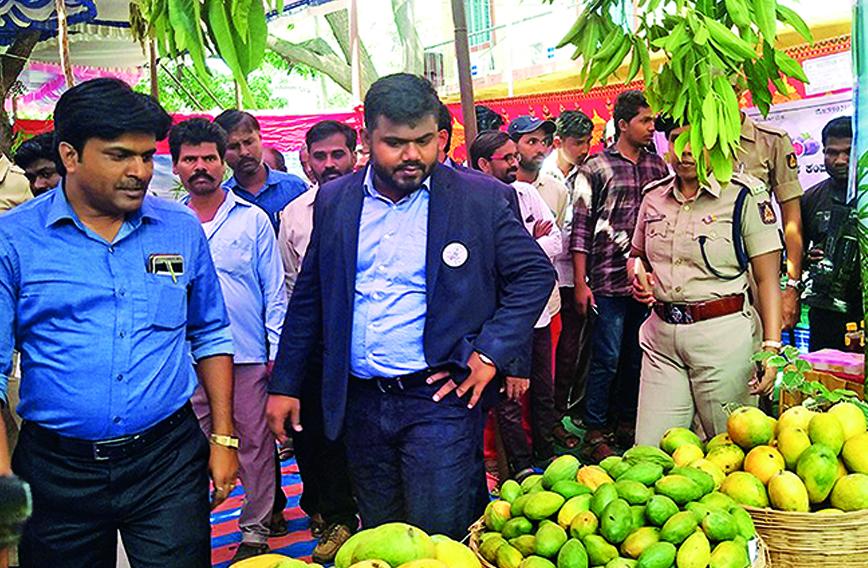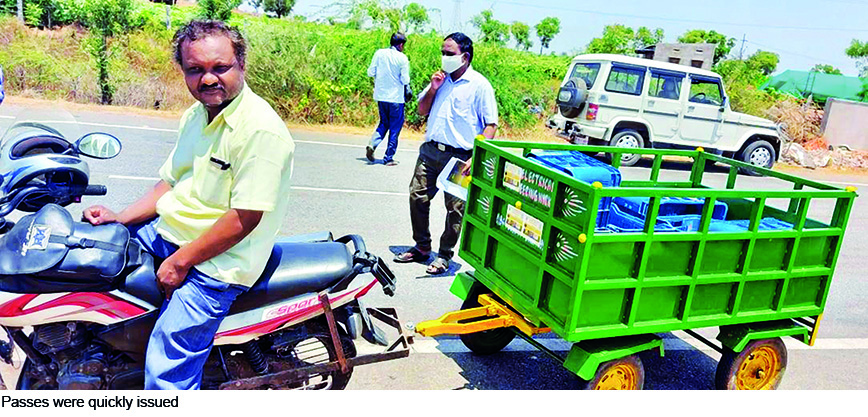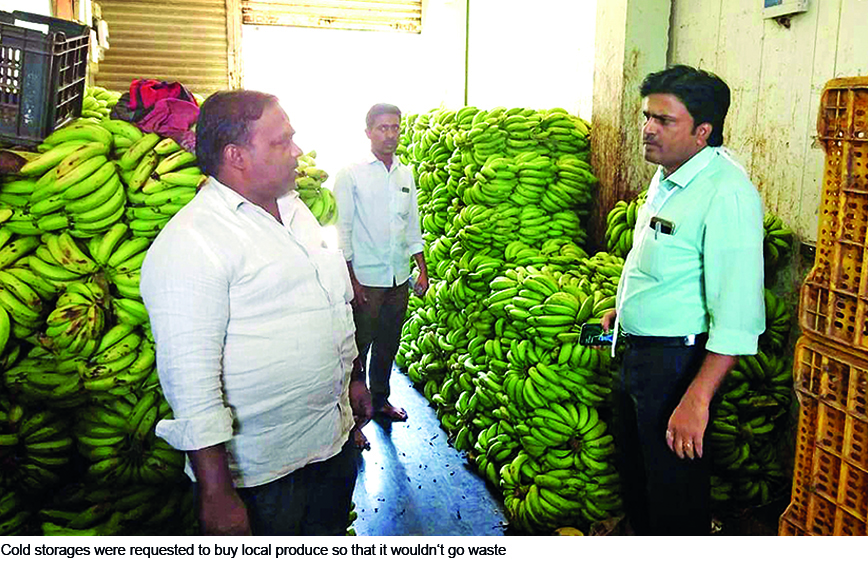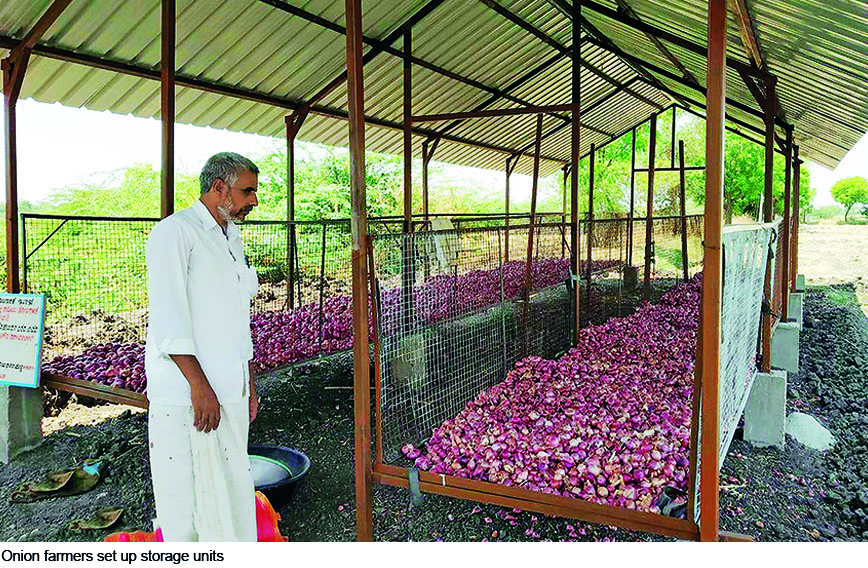
Fruit bowl beats the lockdown
Shree Padre, Kasargod
Kanakgiri Gangadharayya was certain he would earn a substantial profit this March by selling grapes. A farmer in Koppal district of Karnataka, he’d pruned his grapevines a little late last year, figuring it would help him reap a bountiful harvest. And he was right. His field was full of luscious grapes. Last year, he had earned Rs. 12 lakh. This year he thought his grapes would surely fetch him around Rs. 20 lakh.
Then came the lockdown on March 24. Gangadharayya’s dreams turned to dust. Suddenly there were no buyers and no transport. “I was in complete shock. I feared that my entire income would be wiped out,” he recalls.
Like him, hundreds of farmers in Koppal, a fertile fruit and vegetable growing district in Karnataka, were in a state of utter panic. They were staring at huge losses. Tonnes of pomegranates, bananas, grapes, papayas, guavas, figs and citrus fruits were ready for harvest. The fate of Koppal’s most famous fruit, the mango, especially the Kesar variety, hung in the balance.
What should they do? Gangadharayya and other farmers trooped off to meet the district collector (DC), Sunil Kumar, who advised them to get in touch with Krishna Ukkunda, deputy director, horticulture (DDH), of Koppal since three years.
Ukkunda and his department listened to the farmers’ woes and swung into action. Actually, they had been waiting for precisely such a moment. For the past three years the department had tried to persuade farmers to market their produce directly to consumers, adopt new technologies and set up storage facilities. They had even organized fairs and set up buyer-seller meets. But the farmers were indifferent and apathetic.
Now the tables had turned. Farmers were desperately calling officers of the horticulture department. “We have started harvesting, what should we do now?” they asked in anguish.
Ukkunda was sanguine. “The moment I heard about the lockdown, I felt happy. I saw this as a golden opportunity to finally realize my dream of linking farmers to consumers — something we have been advocating all along.”
 Horticulture officers, the administration and the police quickly came together to ensure farmers sold their produce in the shortest timespan possible. Buyers were found, passes issued and storages installed. In the first month of the lockdown, the district succeeded in marketing about 23,000 tonnes of fruits and vegetables thanks to the dedicated activism of the administration, led by the horticulture department.
Horticulture officers, the administration and the police quickly came together to ensure farmers sold their produce in the shortest timespan possible. Buyers were found, passes issued and storages installed. In the first month of the lockdown, the district succeeded in marketing about 23,000 tonnes of fruits and vegetables thanks to the dedicated activism of the administration, led by the horticulture department.
This department has virtually turned into a ‘horticulture produce marketing control room’. Farmers and buyers contact them through the phone, WhatsApp and in person to get their work done.
HARVEST TIME
Although Koppal district gets only 600 mm of average annual rainfall, it is a productive fruit and vegetable growing region. Its main crop is a mango variety which grows on 2,900 hectares. Onion, too, is a major crop.
It has pomegranates growing on around 1,500 hectares, bananas on 1,100 hectares, papayas on 900 hectares, grapes on 780 hectares, guavas on 650 hectares and figs on 210 hectares. A variety of citrus fruits grow on 687 hectares.
When the lockdown began, most grape farmers in Koppal had completed harvesting their grapes. Papayas and watermelons were becoming ready to harvest. Mango is harvested in late April. Onions were waiting. Figs had just ripened.
Ukkunda advised grape farmers to invest quickly in raisin-making units. This way the grapes they couldn’t sell could be stored and sold later.
He helped Gangadharayya instal one such unit and assured him he would sanction the subsidy at the earliest. Gangadharayya got two raisin-making units of 10-tonne capacity each installed within 10 to 12 days during the lockdown.
Farmers like him were put in touch with grape buyers who were given passes quickly. As a result, Gangadharayya could sell about 30 tonnes of fresh grapes for Rs. 28 to Rs. 30 per kg. Prices were hovering around Rs. 35 per kg prior to the lockdown. He also converted his grapes into one tonne of raisins which he has stored in a cold storage to sell when prices rise. About 10 tonnes of his fruit went waste during the early days of the lockdown, he says, causing a loss of Rs. 3 lakh.
“But I have no regrets. If the DC and horticulture officers had not helped me, my entire crop this year would have rotted,” he says with obvious relief. “The DC was so kind. I didn’t need anyone’s help to meet him. He listened patiently and advised remedial measures.”
 Bheemarao Deshpande, a grape farmer of Katagalli in Yalaburga taluk who owns five acres, was on the verge of harvesting grapes when the lockdown was declared. Last year, he had harvested 13 tonnes and earned Rs. 35 per kg.
Bheemarao Deshpande, a grape farmer of Katagalli in Yalaburga taluk who owns five acres, was on the verge of harvesting grapes when the lockdown was declared. Last year, he had harvested 13 tonnes and earned Rs. 35 per kg.
He too approached the horticulture department in March-end. They helped him find buyers and advised him to also instal a raisin-making unit. With his family members and a few workers, he erected the unit. It cost him Rs. 1.7 lakh but he will get a subsidy of Rs. 90,000.
“There is an added advantage. After grape buyers take the best bunches we are stuck with leftovers. By converting the fruit into raisins we can now sell all that we grow,” says Deshpande.
He now has three tonnes of raisins parked in the cold storage. “I don’t have money in hand but my raisins are like a fixed deposit. I am happy that no portion of my crop has been wasted. All the credit for this crisis management has to go to the horticulture department,” he says gratefully. Koppal district now has around 20 raisin-making units.
HELPLINES FOR FARMERS
The horticulture department’s first crisis management step was to set up helplines for farmers and publicize them on social media. “Farmers who want to sell their vegetables and fruits can contact these officers between 7 am and 11 pm,” said their post. It had the phone numbers of the DDH, all senior assistant directors of the taluks, officers of the APMC (Agriculture Produce Marketing Committee) and of HOPCOMS (the state’s co-operative marketing society). The DDH’s office had two mobile vending vans lying idle. They had been specially converted by IIHR (Indian Institute of Horticulture Research) into vending vans to encourage farmers to sell their produce directly to consumers.
After a brainstorming session, the DC and DDH sent word to two young farmers. “We will provide you with two mobile vending vans and a pass to sell directly. Are you interested?” The farmers grabbed the opportunity. Since all fruit and vegetable shops were closed, they did brisk business and made Rs. 3,000 per day. Word spread.
Suresh Chowdaki, one of the farmers selling from the van, says he had grown a lot of brinjal, which he used to sell for Rs. 15 to Rs. 20 per kg. When the lockdown was declared he couldn’t find a buyer for even Rs. 2 per kg. Thanks to the van, he made between Rs. 12,000 and Rs. 15,000 per day. He sold all his brinjals and started buying vegetables to sell.
Thereafter, horticulture officers began cajoling farmers to sell their vegetables and fruits themselves to consumers and offered them passes. They pointed to Chowdaki as a shining example of success.
 Finally, farmers decided to take the plunge. The officers were careful not to issue passes to two vehicles for the same area. Within a month the number of vending vehicles increased to 200. The administration, consumers, the police and farmers were happy. Citizens didn’t need to crowd around markets and social distancing was maintained.
Finally, farmers decided to take the plunge. The officers were careful not to issue passes to two vehicles for the same area. Within a month the number of vending vehicles increased to 200. The administration, consumers, the police and farmers were happy. Citizens didn’t need to crowd around markets and social distancing was maintained.
Linganagouda Patil, a Senior Assistant Director Horticulture (SADH) from Gangavathi taluk, talked to the Bhajantris, a community who traditionally earned their livelihood by selling fruits in crowded places, to include vegetables by buying directly from farmers and hawking in residential areas. The Bhajantris were happy to do this, since the lockdown had rendered them jobless. To ensure their areas didn’t overlap they were allotted separate areas of operation. About 700 push carts and hundreds of two-wheelers loaded with fresh farm produce now spread across the district.
Confined within their homes, with eateries and bakeries closed, people readily bought fresh farm produce when it sailed past in front of their eyes. “You could say they became sort of captive consumers,” says Patil.
One month after the lockdown started, sales of horticultural products in the district came to 5,995 tonnes valued at Rs. 353,80,000. This means every day 200 tonnes of produce worth Rs. 11,79,333 were sold.
“Many farmers have realized that direct marketing is the key to prosperity. After deducting expenses they had 50 percent more returns,” said Ukkunda.
LIST OF BUYERS
The DDH’s office also compiled a list of traders who routinely bought vegetables and fruits. A database of 500 buyers of onion and 150 buyers of watermelon, papaya and other fruits and vegetables was put together and widely circulated among farmers.
“Thanks to the various fairs we organized in previous years, we could get contacts of buyers immediately. Details of crops that we have in the district were sent to them,” says DC Sunil Kumar.
“We worked overtime for a week to draw up this list,” recalled Ukkunda. “Previously, a few farmers wouldn’t divulge the details of buyers they had sold to. We made all such details available to farmers.”
This database of buyers proved very useful for farmers. Language barriers were overcome. In almost all farmer families there is a second generation that knows English. Local drivers of national permit lorries which were lying idle also know a few languages and they helped farmers converse with traders. There were also some 50 to 60 WhatsApp groups which shared information.
Passes were given without any red tape for transporting horticultural produce. “Farmers acknowledge that our district started this process long before other districts. We issued passes from our office and from the horticulture office. This helped farmers transport their produce not just within the district but to some other states as well,” said Sunil Kumar.
 “Many times it was tough for farmers to come to our office to collect their passes. Police wouldn’t allow them. So we sent passes to the farmers. There were days we delivered 10 to 15 passes to their doorsteps,” said Ukkunda.
“Many times it was tough for farmers to come to our office to collect their passes. Police wouldn’t allow them. So we sent passes to the farmers. There were days we delivered 10 to 15 passes to their doorsteps,” said Ukkunda.
Nazeer Ahmad, SADH in Koppal, took personal interest in ensuring farmers got a fair price. When Hanumanthappa Katapura, a papaya farmer with three acres in Irkalagada, contacted him in alarm, he quickly put him in touch with a buyer in Chitradurg who agreed to buy his papayas at Rs. 7 per kg.
However, since temples were closed and all festivals cancelled he couldn’t offload the Crossandra flowers he had grown on one acre. All the floriculturists in the district underwent losses.
“Every day we received 20 to 25 phone calls from farmers. Mostly they were worried about selling their produce,” said Ahmad. “When a farmer’s problem was redressed, it was posted on WhatsApp with a picture. We try to link farmers with buyers and support them in selling. We successfully sent fruits and vegetables to other districts and states. We sent papaya to Delhi. Not more than 10 to 15 percent of the district’s horticultural produce might have gone to waste. We started direct marketing to consumers and then the other districts followed.”
ROLE OF COLD STORAGES
The lockdown underlined the critical role cold storages play in the lives of farmers. There were four in Koppal. The government-owned one in Kushtangi taluk could store 500 tonnes. The other three were privately owned and their total capacity was 450 tonnes. All were closed.
Till the lockdown struck, the cold storage owners used to store fruits and vegetables from other districts and sell when prices were remunerative in the off-season.
The horticulture department struck a deal with them. If they helped local farmers they would be permitted to be open so long as they observed safety rules. The storage owners readily agreed.
Ramesh K Bannigol, a banana farmer, has a cold storage of a capacity of seven tonnes. He used to sell five to six tonnes of bananas per day. He would buy bunches of raw bananas for Rs. 5 per kg and sell them after ripening for Rs. 8 a kg. “During the lockdown I bought about 100 tonnes of bananas from farmers and 30 to 40 tonnes of watermelon. If the officers hadn’t taken an interest in reopening my unit, it would have been closed even now and I would have incurred considerable losses.”
 Farmers also benefited from impromptu onion storages. Onions were selling for Rs. 1,500 to Rs. 1,600 per quintal but when the lockdown was imposed prices crashed.
Farmers also benefited from impromptu onion storages. Onions were selling for Rs. 1,500 to Rs. 1,600 per quintal but when the lockdown was imposed prices crashed.
Horticulture officers had often tried to persuade onion farmers to construct storages so that they wouldn’t have to sell immediately after harvesting. Demos were also arranged but the farmers showed no interest.
Finally, during the lockdown, the onion farmers decided to opt for it. Six farmers of Odaganala village took a welding unit owner to see how such a storage unit was fabricated and then make a similar one for them. One of the farmers, Mahantha Gowda Mali Patil, has been cultivating onions on his six-acre plot for decades. He spent Rs. 1,30,000 on making a storage unit with a capacity of 25 tonnes. He will get a subsidy of Rs. 85,000 from the department.
“I believe we can store onions for four or five months in this unit. We sold some stock in between but six of us now have a stock of 100 tonnes. If we hadn't acted quickly none of our crops would have been saved,” he said.
His case encouraged other onion farmers to get similar storage units constructed. “Our neighbouring village, Handrala, is far ahead in onion cultivation. They have about 5,600 acres under onion cultivation. They seem to have grown onions everywhere. Even a farmer with one hectare of onion is constructing a storage unit to augment his income,” remarked Patil.
“During difficult times, horticulture officers have voluntarily worked overtime to solve our problems. Generally, to get any subsidy sanctioned under any scheme, one has to chase officers. But in our case, it is the officers who prevailed on us to implement all this. They actually tried to compel us,” said Patil.
 Subrahmanya of Gunnala village in Yalaburga taluk grew figs on 18 acres. This fruit has the shortest shelf life. It can survive just one or two days after being harvested. When the lockdown began, Subrahmanya lost `4 lakh worth of figs because the fruit dried up since harvesting was delayed.
Subrahmanya of Gunnala village in Yalaburga taluk grew figs on 18 acres. This fruit has the shortest shelf life. It can survive just one or two days after being harvested. When the lockdown began, Subrahmanya lost `4 lakh worth of figs because the fruit dried up since harvesting was delayed.
The department linked fig farmers to local sellers who have been buying one to one and a half tonnes every day for Rs. 24 per kg instead of Rs. 35 which was the earlier price.
“We harvest about five to six tonnes of crop every day. We are ready to send our figs to other districts and states. The officers are also ready to issue passes. Unfortunately, the centres which regularly buy from us are closed so we have no choice,” said Subrahmanya who is planning to put up a fig drying unit next year.
MANGO’S RISE
The horticulture department’s Mango Fair was an annual affair, held just before the monsoon. Watermelon, grape, pomegranate and musk melon fairs were also held during their peak season. The Mango Fair often went on for over a week and used to net a turnover of Rs. 1 crore.
Mango is Koppal’s main crop, grown on more than 3,000 hectares. Since this year was a rest year in a three-year cycle, farmers feared they would get only 10,000 tonnes or one-third of their regular output. The second blow was that the Mango Fair would not be held this year. So marketing opportunities would be lost.
Moved by the disappointment of the farmers, the horticulture department ideated and arrived at a solution. Proposals for branding the Koppal Mango had been in the air for quite some time. This was the best time to go ahead with it, it was decided.
The department approached the Karnataka State Mango Development and Marketing Board and requested financial help to produce cardboard boxes. The board obliged and 10,000 boxes arrived at Koppal. Each box costs Rs. 29 and can hold 2.5 kg of mangoes, priced at Rs. 250.
Keeping social distancing in mind, the department decentralized mango marketing. First, it selected farmers with the best mangoes and trained them in harvesting and post-harvesting practices. Fruits were graded into A, B and C categories. The best Kesar, Apoos and Beneshan varieties were to be sold under the brand name of ‘Koppal Mango’, in boxes.
Ten farmers grow these varieties. Their names and telephone numbers were listed on a handbill and circulated through social media. Four vans directly sold boxes of Koppal Mango in the city and through doorstep delivery. In a week, about 1,500 boxes were sold.
Three years after the department launched the annual Mango Fair, the Kesar variety began to rise in popularity. An exporter from northern India arrived to assess its worth. The fruit ripens in Koppal by end-April whereas in Gujarat, the prime home of Kesar mangoes, it ripens only by the second week of July. The exporter quickly signed up with a plantation to buy Kesar mangoes worth Rs. 2 lakh. Other exporters followed and now a few farmers are earning Rs. 10 lakh each by selling mangoes to them after signing an agreement.
 Out of 3,000 hectares, the Kesar variety is grown on about 1,200. Because of the premium it fetches it is becoming the preferred choice of farmers.
Out of 3,000 hectares, the Kesar variety is grown on about 1,200. Because of the premium it fetches it is becoming the preferred choice of farmers.
The problem was getting good quality planting material. It was available in different areas of the district. To resolve this problem, the department under Ukkunda organized a 10-day Sasya Santhe or plant market where Rs. 2 lakh worth of plants were sold.
“For our first Mango Fair, we had to compel farmers to participate. But when they saw several varieties of mangoes and managed to sell theirs at good prices, they got interested,” said Ukkunda. After that, whenever the department announced the date of the Mango Fair, farmers would immediately book stalls.
“Out of 850 mango farmers, more than 100 have understood the advantages of marketing directly. Three years ago, none of them knew about this concept,’ said Ukkunda.
“The lockdown crisis has made farmers understand that raisin-making and onion storage are essential for them to withstand the challenges they face in the market,” said Ukkunda. “Figs are an example. Farmers grow them on a big scale. But it is the farmers who dehydrate and sell figs who earn much more. They have also understood that direct marketing is the key to success.”
The time is ripe for Koppal’s farmers to organize themselves into a farmer-producer company or a cooperative society. Delay might dampen the tempo and enthusiasm generated during this period.
Contact: Krishna Ukkunda, DDH, Koppal – 94489 99237
Comments
-

Amit Kumar Bose - July 19, 2020, 10:38 a.m.
Heartwarming news! Mr Ukkunda has performed his call of duty.
-

Dr. Anita Patil Deshmukh - June 29, 2020, 5:52 p.m.
This is an extra-ordinary and deeply inspiring story... Of Shri Krishna Ukkunda. What change one Individual can bring about.....Salam and Namaskar to this officer whose Vision, Passion and Investment into the wellbeing of his farmer friends led him to inspire his entire team to ideate, conceptualise and execute so many schemes to help the farmers sell their crop in this unprecedented circumstances and prevent them from sliding into poverty. From Vending vans to raisin making units to storage units! Absolutely amazing. I do hope this story is read and emulated by many officers across the country to help farmers. In our entire economy, farming is the only business where the producer remains poor while everyone else benefits. This story shatters that reality! Thank you Sir for standing by your farmers and helping them to lead a life of dignity!
-

Mallika Sarabhai - June 29, 2020, 3:39 p.m.
This shows how amazingly well a system can work to alleviate poverty and bring dignity if officers so want. If only there were more officials who genuinely want to bring hope and joy and livelihoods, we could become a strong country



